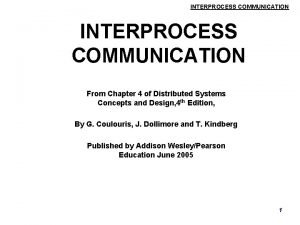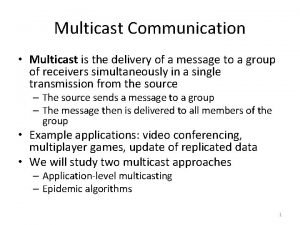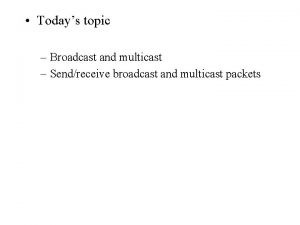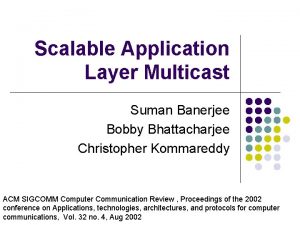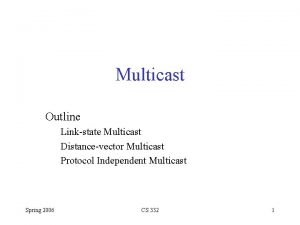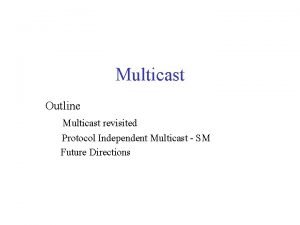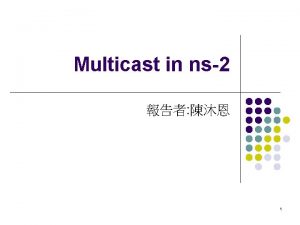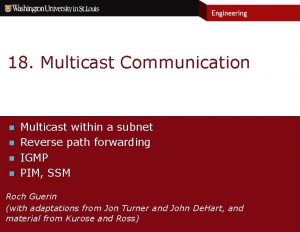Multicast Communication Multicast is the delivery of a












- Slides: 12

Multicast Communication • Multicast is the delivery of a message to a group of receivers simultaneously in a single transmission from the source – The source sends a message to a group – The message then is delivered to all members of the group • Example applications: video conferencing, multiplayer games, update of replicated data • We will study two multicast approaches – Application-level multicasting – Epidemic algorithms 1

Application-Level Multicasting • In application-level multicast, nodes (i. e. application processes) are organized into an overlay network and multicast messages are sent along multicast trees created on the overlay network – Sender is the root of the tree – The tree spans all the receivers • In network-level multicast, routers maintain multicast trees created on the physical network and forward multicast messages along the trees • A connection between two nodes in the overlay network may cross several physical links routing messages within the overlay may not be optimal in comparison to networklevel multicast 2

10 When A sends a multicast message to B, C, and D using a tree in the overlay network (black), cost = cost(A-B) + cost(B-D)+cost(D-C)=9+24+7=40. When A sends a multicast message to B, C, and D using a tree in the physical network (red), cost = 1+7+1+10+1+5+1=26 3

Multicast Tree Construction in Chord • Let S be the initiator of a multicast session • S generates a (randomly chosen) multicast identifier mid, then looks up succ(mid) and promotes it to be the root of the multicast tree • If node P wants to join the multicast tree – it executes Lookup(mid) to send a join request toward the root – it becomes a forwarder in the tree • When the join request arrives at a node Q – If Q has not seen a join request for mid before, it becomes a forwarder and P becomes the child of Q. Q will continue to forward the join request toward the root – If Q is already a forwarder for mid, P becomes the child of Q and Q does not forward the join request • Sending a multicast message: – Sender sends the message toward the root by executing Lookup(mid) – The root then sends the message along the tree 4

Epidemic Algorithms (1) • In large-scale distributed systems, epidemic algorithms are used to rapidly propagate information among a large collection of nodes with no central coordinator – No need to set up a multicast tree • Assumptions – All updates for a specific data item are initiated at a single node (i. e. , no write-write conflict) – We can distinguish old data from new data because data is timestamped or versioned • Basic idea: – When a node is updated, it tries to “infect” other nodes as quickly as possible using pair-wise exchange of updates (like pair-wise spreading of a disease) – Eventually, each update should reach every node 5

Epidemic Algorithms (2) • Terminology – A node is called infected if it holds an update that it is willing to spread to other nodes – A node is called susceptible if it has not yet been updated – A node is called removed if it is not willing or able to spread its update • We will study two propagation models – Anti-entropy – Gossiping 6

Anti-Entropy • A node P picks another node Q at random and exchanges updates with Q using one of the three approaches – Push: P only pushes its updates to Q – Pull: P only pulls in updates from Q – Push-Pull: P and Q send updates to each other • A pure push-based or pull-based approach does not help spread updates quickly – Push-based approach is better at the beginning (i. e. , when a small number of nodes are infected) – Pull-based approach is better towards the end (i. e. , when a large number of nodes are infected) – Push-pull is the best strategy • If there are N nodes in the system, it takes O(log(N)) rounds to disseminate an update to all nodes – A round is a period in which every node has taken the initiative to exchange updates with another node 7

Gossiping • When a node P receives an update, it tries to push the update to an arbitrary other node Q • If Q was already updated by another node, P stops spreading the update (i. e. , becomes removed) with probability 1/k • Gossiping can rapidly spread updates, but cannot guarantee that all nodes will be updated – When there is a large number of nodes, the fraction s of nodes that will remain susceptible satisfy the equation s=e-(k+1)(1 -s) – Example: when k=4, s < 0. 007 • After a certain time, we can run an anti-entropy protocol to ensure all nodes are updated 8

The relation between the fraction s of susceptible nodes and the parameter k in gossiping. The graph displays ln(s) as a function of k.

Removing Data • Epidemic algorithms are excellent for spreading updates, but deletion of data items is hard – When a node deletes a data item, and then receives an old copy of the data item, the old copy will be interpreted as something new – The node can’t distinguish between a deleted copy and no copy! • Solution: use death certificates – Treat deletes as updates and spread a death certificate – Ever node keeps a record of the deletion using death certificate – Death certificates should eventually be cleaned up 10

Removing Death Certificates • A death certificate is timestamped when it is created • Assuming death certificates propagate to all nodes in finite time, death certificates can be removed after this maximum propagation time has elapsed • To provide hard guarantee that deletions are spread to all nodes, a few nodes maintain dormant death certificates that are never thrown away – Suppose node P has a dormant death certificate for data item x. If P receives an obsolete update for x, p will spread the death certificate for x again. 11

Information Aggregation Using Epidemic Algorithms • Let every node i maintains an initial value xi • When node i contacts node j, they each update their value to (xi + xj)/2 • In the end each node will have computed the average , where N is the number of nodes • What happens if initially xi = 1 if i=1 and xi = 0 if i>1? – Eventually each node will compute the average (i. e. , xi=1/N), so every node can estimate the size of the system as being 1/xi! 12
 Udp datagram communication in distributed system
Udp datagram communication in distributed system What is multicast communication in distributed system
What is multicast communication in distributed system Accenture delivered
Accenture delivered Unicast multicast broadcast address example
Unicast multicast broadcast address example Bimodal multicast
Bimodal multicast Broadcast and multicast
Broadcast and multicast Unicast vs multicast
Unicast vs multicast Unicast vs multicast vs broadcast
Unicast vs multicast vs broadcast Multicast
Multicast Multicast
Multicast Calico multicast
Calico multicast Pengertian multicast
Pengertian multicast Bobby bhattacharjee
Bobby bhattacharjee
